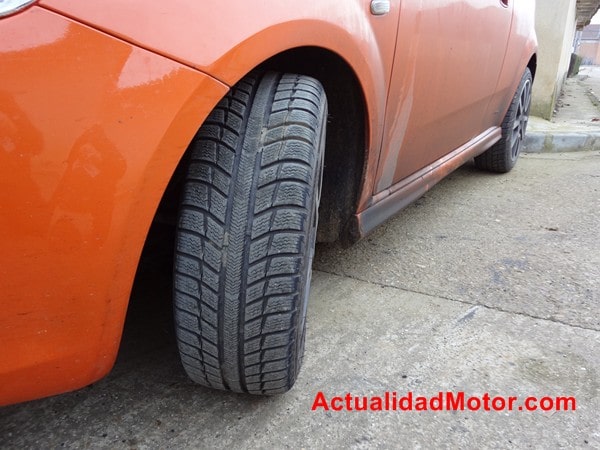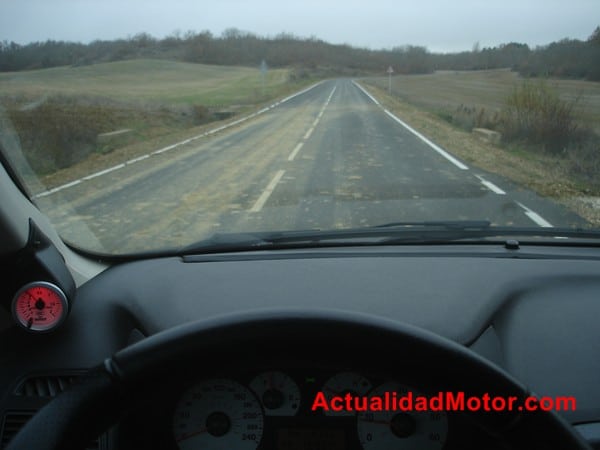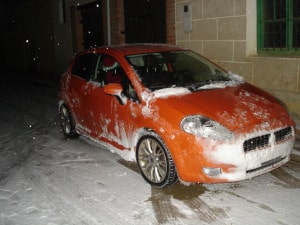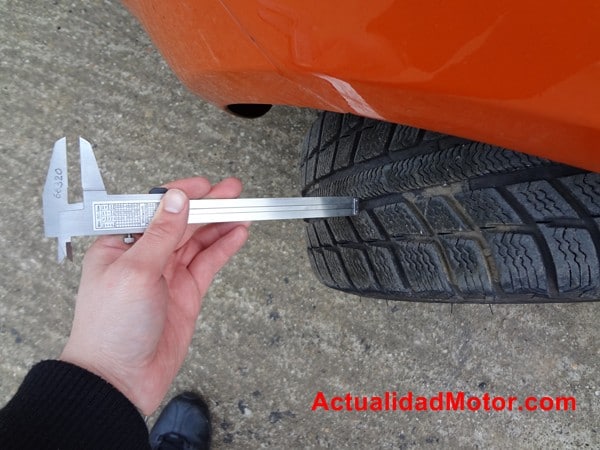En Actualidadmotor.com we are making one long-term test with winter tires. Already we have 6.000 km with the indispensable and necessary Michelin Primacy Alpine in measure 205/45/17, it is time to recapitulate the sensations experienced, the behavior in general of the tire and stop to make our first measurement of wear
My driving sensations on dry ground
En driving on dry ground offer good performance something worse than a good summer tire, but with the advantage that its grip is not so dependent on temperature. Another advantage that I have found with the winter tire is that it offers a lot more safety when driving on roads with changing ground: For example, circulating in full winter on a completely dry road, suddenly after a curve the typical shadow appears where the sun does not hit. The road is wet and slippery, but the winter tires hardly feel the transition between dry and wet ground.
The benefits offered by the winter tire with normal weather (15ºC) are very similar to those offered in cold temperatures (between 0 and 4ºC), that is, it is more linear and progressive. On the other hand, the summer tire does show this difference in temperature (from 15 to 0ºC), varying its behavior and grip.
On the contrary, the summer tire will work perfectly from 7ºC upwards, while the winter tirerising above 14ºC, it moves away from its temperature of use and will not offer the same security than the summer tire.
Driving on wet ground
Today the sky is giving abundant rain. Apparently it has been raining all night although I haven't noticed. The thermometer in my car reads 5ºC as I pull out onto a secondary road. I take advantage that I go for one deserted urbanization for paste a couple of sudden stops at pedestrian crossings…it is nice to see that the road markings slip a little less in the wet if you wear winter tires. Still, it's embarrassing to me how dangerous this paint can be (and as far as I know, bikes don't have winter tires).
I go out to minor road where abundant puddles welcome me and an asphalt that does not drain well, despite the fact that this road was fixed a couple of years ago. The sense of security is superior to what I expected: the aquaplaning completely disappears and the tires leave a mark on the road clearly visible in the rear view mirror. Tire manufacturers say un tire in summer it can evacuate about 15 liters of water every second! (i.e. one full bucket per second). I don't know how much they can evacuate Michelin Primacy Alpine that I carry, but it must be a lot.
I tackle the first corners at a smooth pace and I don't notice anything special. I pick up the pace, forcing the brakes a lot and a little less in the curves (for fullfilment of security requirements), noting strangely that nothing special is noticeable. Obviously this is one of the objectives of winter tires, to be able to drive on a cold and flooded road at a high speed providing a plus of security.
According to Michelin , on wet ground at low temperatures, braking distance from 80 km/h is 34 meters with winter tires, while with summer tires the braking lengthens up to 40 meters. I don't have any tools to check it, but I can assure you that it can be fully braked with some peace of mind.
Tire evacuating water in a laboratory test
I leave the secondary road and take the highway A-62 heading south. This road supports a very high traffic and the pavement is very degraded in some places, while there are recently restored sections. The result is thate changes from a very good asphalt with good drainage to another with large accumulations of water in a matter of meters, continually. From time to time, I voluntarily pass with the wheels on the right side through small pools of water that form parallel to the continuous line that delimits the hard shoulder, observing a very high aquaplaning resistance.
The evening progresses and the temperature has dropped considerably. Apparently the tires are not the only ones that suffer from the effects of the cold, since the suction cup that I usually use to attach the camcorder to the car when shooting videos has become stiff and does not stick. Curious, right?
My driving sensations in shallow snow
I thought that on my trip to French pyrenees was going to find snow, but it has not been the case, I have had to wait. Suddenly, without warning on the way back from a trip to the northern part of Leon it has started to snow and quickly the road has been covered by a thin layer of snow. The thermometer now reads 2ºC and the snow cover is 1cm or less. In these conditions we cannot put chains, because the metallic ones destroy the asphalt (and therefore are prohibited) and the cloth ones would not last more than a few minutes.
It is these moments is where winter tires put a smile on your face. The deep grooves of the drawing are responsible for evacuating much of the snow and lamellae grab (as far as possible) to the road or to the snow that remains on it. The special mixture of tread rubbers work well at low temperatures and enable the tire to perform as expected. Lunlike now with a summer tire it is ABYSSMAL, hard to explain in words. It is simply the difference between having to try to drive with extreme caution and at very low speeds or being able to drive relatively normally, always at moderate speeds, without forgetting that we drive on snow.
Winter tire life
The tires Michelin Primacy Alpine PA3 that I have mounted on my car have when they are new a 9mm drawing. They are supposed to be usable in cextreme conditions until they have 4mm of drawing. From there to the legal limit (1,6 mm), the tires are perfectly Usable in rain and cold, but they lose performance in snow and ice.
I have measured the tread on the new "equivalent" summer tire (Michelin Pilot Sport 3) and is 8,2 mm deep. That is, the winter tire (at least to this extent) has almost 10% more “legal” depth to wear out This should work for compensate for the greater wear that winter tires theoretically suffer compared to summer.
Gauge in hand, I measure the wear of my tires after 6.000 km of varied use:
- Front tires: between 7,6 and 7,8 mm (81% remaining tread –> 31.500 km life expectancy)
- Rear tires: 8,6mm (94% remaining tread remaining–>74.000km life expectancy)
We can see that Front tires wear twice as fast as rear tires, in part due to the driving more demanding than normal that I am doing during the whole test.
Assuming that attrition remains as before, the front tires will last me two winters and the rear four. How logical would it be rotate them, it can be said that the four tires will last me two winters in full power and I would still have rubber left to spend another few months of spring or autumn until they are completely worn out.
For now, it seems true that winter tires last almost as long, we will continue doing kilometers and measuring wear.
Continued ...
- Gauge doesn't lie and shows accumulated tire wear
- This photo is old, but it illustrates the situation well












